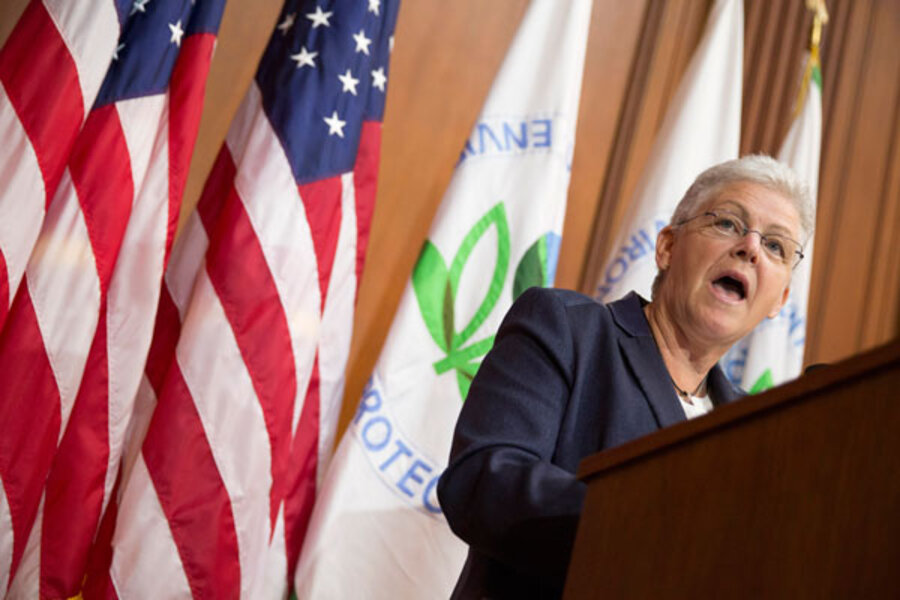EPA proposes big emissions cuts: Would the climate even notice?
Loading...
From the atmosphere's standpoint, the reductions envisioned by the US Environmental Protection Agency's proposed rules governing carbon-dioxide emissions from fossil-fuel power plants are modest at best.
The draft rules, which will go through a one-year comment phase, mark an important policy step for the US – a step that will address 40 percent of its annual greenhouse-gas emissions and some 16 percent of electric utility emissions globally, advocates say. Many hope the move will boost the country's credibility at global climate talks, which aim to finish a new climate treaty in Paris in 2015 that brings more countries on board.
That broader context is crucial, say analysts. By itself, "the rule alone won't significantly alter the global emissions trajectory, but the same could be said of any individual step," says Elliot Diringer, executive vice president of the Center for Climate and Energy Solutions (C2ES), a nonprofit think tank in Arlington, Va.
But the proposed rules, which represent one of the biggest steps the US has yet undertaken to curb greenhouse-gas emissions, can help get the ball rolling.
"For the moment, we're just pleased to see the proposal on the table," says Kevin Kennedy, director of the US Climate Initiative at the World Resources Institute, an environmental policy research group in Washington.
His group, like some others, is crunching the EPA's numbers to see if they add up. But Mr. Kennedy adds: "This framework we know can be used to get very significant reductions."
With House Republicans opposing action against climate change, President Obama laid out a larger Climate Action Plan last June based on executive actions he could take without congressional approval. But executive actions are less sweeping than congressional laws, so it's no surprise that, from the atmosphere's standpoint, the contribution the proposed regulations could have on their own is small.
The rules envision reducing annual CO2 emissions from the electricity sector by 30 percent below 2005 levels by 2030. In 2005, US power plants in the US emitted 2.4 billion metric tons of CO2 into the atmosphere, according to the US Energy Information Agency, or about 8 percent of total global CO2 emissions from fossil fuels that year.
Without the rules, most models project that these CO2 emissions would drop anyway as the economy responds to new technologies or changes in the economics of energy – such as the increasing availability of natural gas, whose cheaper price has undercut coal. This "would be about an 8 to 11 percent reduction," says Kenneth Kimmell, president of the Union of Concerned Scientists in Cambridge, Mass.
The new rule, then, "would drive an additional 20 percent reduction, which is significant," he adds.
Since CO2 resides in the atmosphere for a long time, avoiding emissions helps.
The EPA's draft rules do not aim to significantly change the mix of power generation in the US. Coal and natural gas would still each provide more than 30 percent of US power generation in 2030, the draft rules state. That is comparable to current proportions.
Even so, "if you strike the right balance of flexibility and stringency, this can send a real investment signal to the energy community," finding payoff in longer-term emissions reductions, says Kennedy of the US Climate Initiative.
Beyond CO2 emissions, the plan could bring significant health benefits, public health officials say. EPA efforts to deal with greenhouse gas emissions would also cut emissions of a suite of other harmful pollutants such as mercury, sulfur dioxide, nitrous oxides, according to a study released last week by researchers at the Harvard School of Public Health and Syracuse University.
Monday's release of the EPA's draft rules are aimed as much at an international diplomatic audience as to domestic audiences, policy analysts suggest.
"It does allow the United States to say: We are trying to get our own house in order," says Mr. Kimmell of the Union of Concerned Scientists. A lack of significant federal action since President George W. Bush pulled the US out of the 1997 Kyoto Protocol has been a major sticking point in global climate talks, which have aimed to prompt countries such as China, India, Mexico, Brazil, and South Africa to take action.
The stated global goal is to stand a 50-50 chance of holding increases in global average temperatures to 2 degrees Celsius by the end of the century. To follow that path at the least cost, global greenhouse gases would have to peak in 2020, according to the UN-backed Intergovernmental Panel on Climate Change.
Yet current global emission-reduction commitments fall short of that goal. "We are certainly on a trajectory that is more along a 5-degree path than a 2-degree path," says Thomas Boden, who heads the Carbon Dioxide Information Analysis Center at the Oak Ridge National Laboratory in Tennessee.






